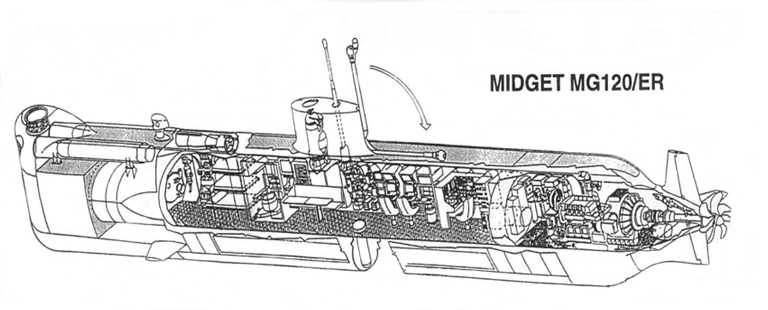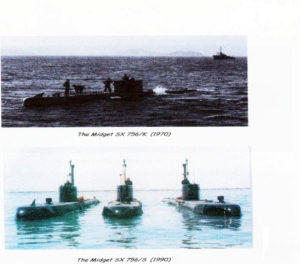In 1998, the former Flag Officer In Command of the Philippine Navy, then Vice Admiral Eduardo Ma R Santos AFP, endorsed to the Department of National Defense the concept paper for the development of submarine capability for the Philippine Navy. VADM Santos is the proponent of the nucleus of submarine warfare in the PN.
The Department of National Defense acknowledged the proposal of the Philippine Navy positively. At that point, the Navy organized a core group including of young naval officer to conduct the study and organizational structure of a flotilla of three (3) conventional diesel electric air independents propulsion system that has good performance and stealth in the Littoral waters of the Philippine Economic Exclusive Zone (EEZ).
In support to this program, the Ministry of U.K. Ministry of Defense sponsored the Postgraduate Study of then Commander Tomas D. Baino, a Naval Architect officer for Post Graduate study at the Department of Naval Architecture at the University of London in U.K. specializing in submarine design and construction, and was approved by the Department of National Defense of the Philippines at no cost to the Philippine Government.
Other countries, who are long established submarine operators, are also looking at ways of improving capabilities in submarine warfare. For most of the aspiring submarine operators, the emerging overriding mission of submarine operation in Littoral and coastal defense using small attack submarine in extremely shallow water as a mobile flat form and underwater minefield. The course was participated by the engineers /naval architect representatives from U.K. Royal Navy, Bazan of Spain, Spanish Navy, Brazilian Navy, Pakistan Navy, and U.K. Defense Evaluation Research Agency (DERA) and others.
The Operational Requirement of the submarine will be deployed in forward areas of the Exclusive Economic Zone (EEZ) for naval presence, surveillance, intelligence and monitoring and interdiction of illegal activities in the EEZ. The surveillance operation will include both coastal areas and islands.
TASKS
Crises Situation (Low Intensity Conflict)
- The submarine will be deployed on defensive mode to protect the sovereignty of the state. The specific tasks are the following:
- To detect, classify, and attack hostile surface and sub-surface contacts;
- To gather reconnaissance information pertaining to hostile forces intruding the territorial waters and occupation of island of the state;
- To carry out mine laying operation in confined water such as channel, straights, passages, bays and harbor entrances;
- To embark SEAL team, launch and recover personnel and equipment on shore; and
- Do limited anti air (by opportunity).
Peacetime Situation
The design of the submarine is flexible to allow following peacetime tasks to be carried out economically.
- To participate in joint naval exercise;
- To assist in special operation such as responding against action, piracy, and smuggling;
- To assist in search and rescue of vessels in distress, especially during bad weather conditions;
- To provide naval presence in the economic zone;
- To assist in the enforcement of IMO regulations and other applicable laws of the high seas; and
- To assist in the conduct of oceanographic study.
AREAS OF OPERATION
The submarine will be expected to operate among the islands of the West Philippine Sea, mostly within the area co-ordinates of Latitude of 10° to 20°and Longitude of 110° to 120°.
The West Philippine Sea is in littoral waters bounded by Taiwan, Japan, and Korea in North, Vietnam, Thailand and Cambodia in West, the Philippine at the Eastern seaboard of Pacific, and Singapore, Malaysia, Indonesia and Brunei in the South. There are four narrow passages, which leads towards West Philippine Sea. These narrow passages are in the strait of Malacca, Sunda Lombok strait in Indonesia, San Bernardino strait and Balintang channel in the Philippines. The water in these avenues of approach towards the West Philippine Sea is characterized by strong tidal rift, shallowness with variable depth between 60-m to 100-m at the sea lane. The density of traffic is high because this is the crossroad to Pacific and Indian Oceans. During low tide, islets, sandbars, shoals and atolls are emerging bare at free water surface. Approximately 60% of this sea area is safe for navigation; the remaining is considered unsafe based on historical records of ships grounding.
The prevailing climate in these seawaters has a temperature of maximum 32oC, a very high percentage of humidity, strong tidal current and in the path of the typhoon belt from June to November every year. The prevailing sea state condition is 4 with wave height 5-m, wave crossing period of 8 seconds. The seawater is clearer, during sunny days, and the sea bottom can be visualized from helicopter flying over the region.
The West Philippine Sea is good fishing ground — various species of fishes are found in the area and is within the migratory route of tuna; piracy is prevalent especially on the approach to strait of Malacca, drug trafficking and records of apprehension are mounting. Spillage and dumping of toxic wastes are very difficult to monitor and control. There are also several occurrences of ship grounding, collisions and sinking due to bad weather conditions.
Also, the South China Sea has an indication of mineral resources deposits, as per records of mineral explorations made in the last fifteen years. The situation in this area is mounting because of overlapping claims on some islands/islets.
LITTORAL SEA AREAS
These are areas close to shore. The characteristic of the physical environment, weather, and climate considerably affect the operation of surface ship and submarines. It is a coast line of land and near-shore water particularly affected by extreme high and low tides. These can be very deep or as shallow as 200 meters or less, typically a narrow sea with variable weather and climate. A short distance and a small area of maneuvering space characterize a narrow sea.
Because of limited open sea area, a high sustained speed for a surface ship is a critical factor for navigation corrective action, should situation become eminent because of the seabed, reefs, shoal which can lead to difficulty that even maneuvering in shallow water can lead to the hull of the ship to squat under the keel.
Movement of submarine through the water also generates on the sea surface a distinctive hump that is detectable at the surface of the water. A nuclear submarine (SSN) in order to operate safely in shallow water must have at least 60-70 feet of water clearance under her keel to the bottom of the seabed for navigational safety. Likewise, the conventional medium size (SSK) needs 30-40 feet clearance. The submarine must at least navigate close to the surface of the sea and must have greater depth under the keel so that in case of emergency she can immediately conduct vertical maneuver and dive.
The problem in shallow water is that Sound Navigation and Ranging (SONAR) sensor equipment is unpredictable because of the seabed proximity coupled with fluctuating variation of sea temperature, fresh-water influx mixed with sea-water from rivers, higher rainfall, and natural as well as ambient noise from the inland activities interfere and can adversely affect SONAR. The passive SONAR (Doppler) receives only echo and picks target acoustic signatures. While the active SONAR’s (i.e., projects sound and receives returning echo), performance is affected by the environmental clutter, and the ability to reliably check the target signature in a narrow tonal band is difficult. SONAR performance depends on the principles of physics that is affected by a change of environmental condition.
In extremely shallow water of an archipelago, the problem of the passive SONAR performance is compounded by strong sound reverberation caused by sound reflection from the seabed and the surface, and the nearby island. Many SONAR contacts are false due to irregularly of sea bottom configurations.
EFFECTIVENESS OF SHALLOW WATER ATTACK (SWATS) SUBMARINE IN LITTORAL WATERS
The SWATS are primarily designed for operation in the littorals and shallow water. They are much in smaller size than conventional submarine (SSK) and nuclear submarine (SSN). The SWAT is very ideal in short haul patrol of 30 days in station in extremely shallow, confined waters with highly maneuverable characteristics with indiscretion ratio of 10% to 12% because of its unique length of 27m and diameter of 3 meters and displacement of approx. less than 150 tons with speed of 10 knots submerged and 8 knots at the surface. It plays a major role in its ability to ensure navigational safety when in stationary ambush position in selected areas such as in channels, base and coastal areas, possible avenues and choke points of approach of the intruding hostile targets. It is capable of striking targets with her 2x torpedoes (acoustic guidance or wire guided), destroy targets at the range of 7-8 km. It carries 16 limpet mines and a SEAL Team for commando operation. It can launch and recover the SEAL Team with basic equipment while in stationary position underwater at a water depth of 60-150 feet of water and submarine diving depth of 150 to 200 ft. depth of 50 meters with close cycle diesel Air Independent Propulsion Unit.
ACQUISITION, OPERATION AND MAINTENANCE COST
A flotilla of three SWATS Class Submarine can be acquired in the rough order magnitude of USD 105.778M with carry onboard of spare parts, technical assistance, and shore base spares or computerized program maintenance procedures. The operational cost would be in the range of USD 6.00M per year per submarine for a deployment cycle of 2,160 hours.
SUBMARINE CAPABILITY AS A STARTING POINT
The Philippine Navy can start developing this capability through the SWATS as a model in order to develop submarine war fighting capability in extremely shallow water, develop confidence, skills and doctrine within the affordable budgetary requirements in underwater warfare. Above all, the SWATS is a moving minefield that is very difficult to detect in littoral shallow water.
RESEARCH AND DEVELOPMENT
Through the Department of Science and Technology (DOST) this type of submarine can be developed and constructed by the local shipyards in the country. Using the SWATS model in partner with Cosmos Spa of Italy, the Philippines can construct several units for the Navy that can provide effective deterrent submarine warfare capability in our EEZ.


Please help Taiwan to create submarines, Taiwan is being suppressed by China. For regional peace, Taiwan to self-made submarines, please submarine manufacturing capacity of the manufacturers through the business model to help Taiwan ship-made submarine